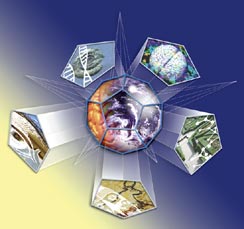| 
ABOVE: ‘New Visions of Nature, Science, and Religion’, Credit: Conceptual design by Tom Rockwell, Painted Universe Inc., Jim Proctor. Artwork by Tom Rockwell and Emily Maletz, Painted Universe, Inc., Steven Brown, UCSB Artworks; Peter Allen, UCSB College of Engineering. Image Permissions: David Griffeath, Primordial Soup Kitchen, Jason Hunt, The Natural Child project. © 2003 The Regents of the University of California.
|  | A newly launched initiative at the University of California, Santa Barbara, asks the central question of our time: What is the nature of Nature? Is nature just atoms and molecules, and thus without intrinsic value, to be exploited however we please? Are human beings just complex assemblages of molecules that have evolved in such a way that they labor under the delusion that their lives have purpose, that it matters what they do? Is the universe a big accident?
There is little within science that offers optimistic answers to these questions, for science is not equipped to address questions of purpose. Religious views of nature, by contrast, are more encouraging. Life is special; human beings are important; what we do matters; the world is a creation of God and has value. In fact, God’s creation is continuing still. The scientific and religious views of nature, including human nature, are not so much at odds with each other, as they are disconnected from each other. But these different views must become an integrated whole. The great philosopher Alfred North Whitehead put it like this: “The future of civilization depends on the way the two most powerful forces of history, science and religion, settle into relationship with each other.”
The new initiative at the University of California, Santa Barbara, under the creative direction of Jim Proctor, is taking up the challenge laid down by Whitehead. The New Visions of Nature, Science and Religion project will look for the connections and points of contact that will join scientific and religious visions. The potential value of the insights that could emerge are both numerous and critically important. Take cloning, for example. Science is on the verge of being able to clone humans but this extraordinary achievement raises deep ethical and theological questions. Consider environmentalism. Our modern way of life takes an enormous toll on the limited resources of the earth—water, fuel, food, air. Should people come to see nature as a ground that is sacred for both science and theology, to develop what has been called an “ecospirituality?” Or would such a move be naïve and counterproductive? Such debates are important.
The New Visions of Nature, Science and Religion project calls for a revisioning of both biophysical and human nature, in a manner informed by scholarship and considerate of both science and theology.
The deep and fascinating questions at the core of the Foundation's mission promote conversation between science and religion. The questions are important, relevant, and largely overlooked. The relevance and excitement of this conversation is bringing together many of the world's leading scholars-skeptics, fence-sitters, and true believers—into its intellectual orbit, like protoplanets around an emerging star, in anticipation of good things to come.
|